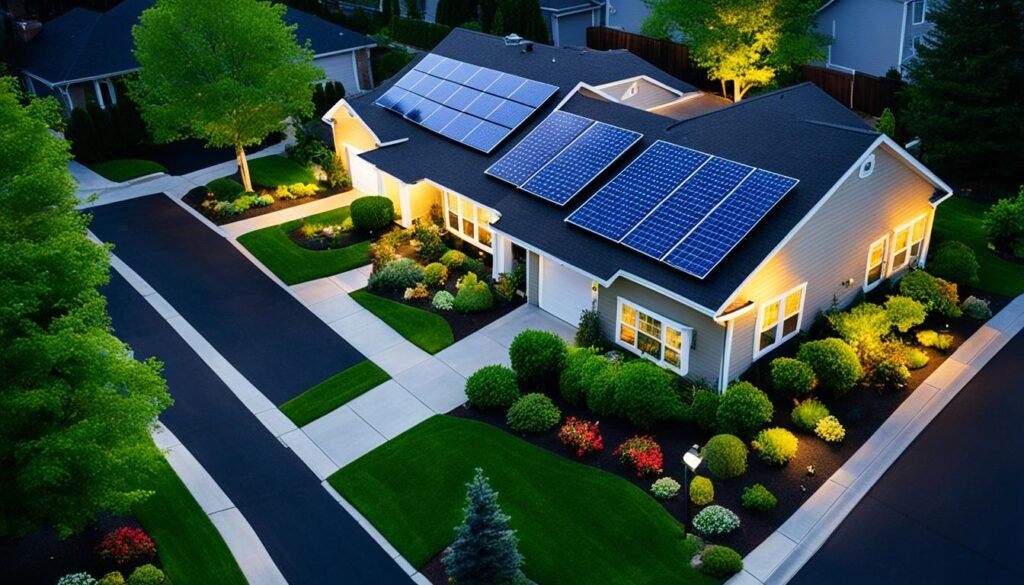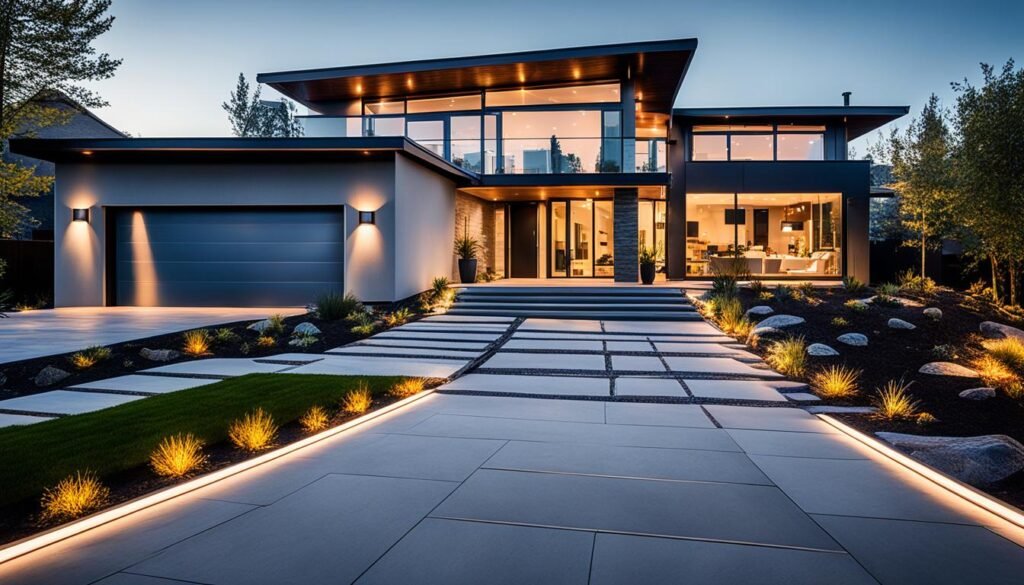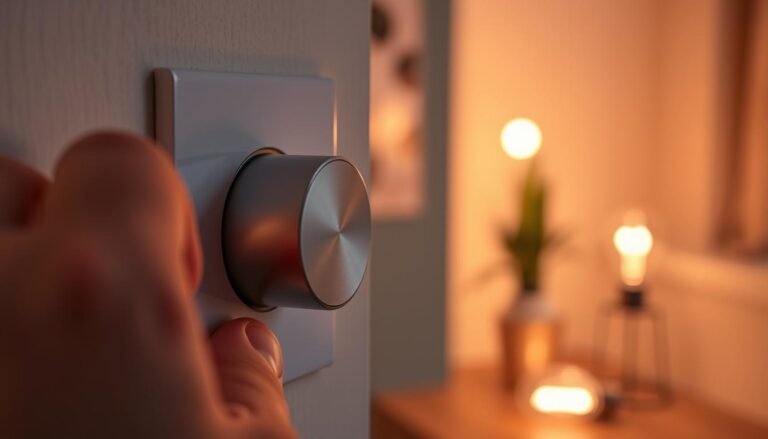Affiliate Disclosure: This post may contain affiliate links. If you make a purchase, we may earn a small commission at no extra cost to you.
Did you know that outdoor motion detector lights can reduce the risk of burglary by up to 39%? That’s right! They not only illuminate your home’s exterior, but they also provide an added layer of security to deter potential intruders.
In this article, we will dive into the world of motion detector lights, exploring their benefits, working mechanisms, and the different types available. Whether you want to enhance the safety of your property, improve convenience, or save on energy bills, these lights are a practical and effective solution for your outdoor lighting needs.
Check out our FREE Calculators on our Resources Page
Key Takeaways:
- Motion detector lights can significantly reduce the risk of burglary.
- They provide added security by illuminating your home’s exterior.
- Motion detector lights offer convenience and energy savings.
- There are different types of motion detector lights available, including solar-powered, battery-operated, and wired systems.
- You can integrate motion detector lights into your home automation system for enhanced security and control.
Understanding the Basics of Motion Detector Lights
Motion detector lights work by utilizing sensors to detect movement and trigger the light to turn on. They are usually equipped with infrared heat wave sensors that can detect the warmth of humans, animals, or cars. When motion is detected, the lights illuminate the area for a specified duration and then automatically turn off.
Motion-activated lights can improve home safety and security by providing visibility in dark areas and deterring potential intruders. They can also enhance convenience by automatically turning on when you approach a specific area. Understanding how these lights work is crucial in choosing the right type for your needs.
Choosing the Right Type of Motion Detector Lights for Your Home
When it comes to motion detector lights, there are various options available that you can choose from based on your specific needs. It’s important to consider factors such as power source, brightness, coverage, weather resistance, and adjustability features. So, let’s take a closer look at the different types of motion detector lights and what sets them apart.
Comparing Solar vs. Battery-Operated vs. Wired Systems

Check out our 4 Utility Room Lighting Tips for Efficiency & Style
These lights are powered by the sun and require no wiring. They are ideal for areas with limited power access, providing a convenient and eco-friendly lighting solution.
Battery-operated motion detector lights:
These lights are easy to install and can be placed anywhere without the need for electrical wiring. They offer flexibility and can be a great option for temporary or remote locations.
Wired motion detector lights:
These lights are connected to your home’s electrical system, offering a constant and reliable power source. They require professional installation but provide stability and long-term functionality.
Assessing Brightness and Coverage for Security and Convenience
When choosing motion sensor lights, it’s important to assess their brightness and coverage capabilities. Look for lights with adjustable brightness levels to suit your specific needs. Consider the area you want to illuminate and ensure that the lights have a wide coverage range.
Evaluating Weather Resistance and Adjustability Features
Weather resistance is a crucial factor to consider, especially for outdoor lights. Look for lights that are designed to withstand various weather conditions, such as rain, snow, and extreme temperatures. Additionally, consider the adjustability features of the lights, such as adjustable motion sensitivity and duration settings, to personalize their functionality.
Choosing the right type of light for your home involves considering factors such as power source, brightness, coverage, weather resistance, and adjustability features. By evaluating your specific needs and preferences, you can find the perfect motion sensor lights to enhance the security and convenience of your home.
Installation Tips for Motion Detector Lights
Installing motion detector lights can be a DIY project for homeowners. Follow these installation tips to ensure a successful setup:
- Choose the right location: Consider factors such as coverage area and accessibility when selecting the location for your lights. Ideally, place them in areas where they can effectively detect motion and provide sufficient lighting.
- Turn off the power: Before starting the installation process, ensure that the power to the area where you will be installing the lights is turned off. This will help prevent any electrical accidents during the installation.
- Follow manufacturer’s instructions: It’s important to carefully read and follow the instructions provided with the motion sensor lights. These instructions will guide you on how to connect the wires and mount the lights securely.
- Test the lights: After the installation is complete, it’s essential to test the lights to ensure they are functioning properly. Test them by triggering the motion sensors and verify that the lights turn on and off as expected.
- Consult a professional if needed: If you are unsure about any aspect of the installation process or if you encounter any difficulties, it may be helpful to consult a professional electrician. They can provide guidance and ensure a safe and efficient installation.
By following these installation tips, you can successfully incorporate motion detector lights into your home and enjoy the convenience and security they provide.
Incorporating Motion Detector Lights into Your Home Automation
Motion detector lights can be seamlessly integrated into your home automation system to enhance security and convenience. By linking the lights to your smart home system, you can create custom lighting schedules, set up automatic triggers, and receive notifications on your smartphone when motion is detected. This integration allows you to control and monitor your lights from anywhere.
Imagine coming home late at night and your motion detector lights automatically turning on to welcome you. Or receiving an alert on your phone when motion is detected outside your home while you’re away. With the right home automation tools, you can make this a reality.
Linking Lights to Smart Home Systems for Enhanced Security
Integrating your motion sensor lights with your smart home system enhances the security of your property. You can synchronize the lights with other smart security devices, such as security cameras or door locks, creating a comprehensive security solution. When motion is detected, the lights can turn on simultaneously with your security cameras recording, providing you with a clear view of any activity.

Programming Your Motion Detection Lights with Home Automation Tools
Home automation tools offer endless possibilities for programming your motion detection lights. You can customize lighting schedules to simulate occupancy when you’re away, deterring potential intruders. Set up motion-based triggers to activate specific scenes or routines, such as turning on specific lights and adjusting their brightness when motion is detected in certain areas.
Moreover, you can incorporate motion sensor lights into your voice-controlled smart home system, giving you even more control. Simply use voice commands to turn on or off the lights, adjust their brightness, or activate specific scenes.
With the flexibility and convenience of home automation tools, programming your motion detection lights has never been easier.
The Environmental and Cost Benefits of Motion Detection Lights
Motion detector lights provide significant energy savings and have a positive eco-friendly impact. By utilizing motion sensing technology, these lights only turn on when motion is detected, making them more energy-efficient compared to traditional lights that stay on all the time. As a result, motion sensor lights contribute to reduced energy consumption and lower electricity bills.
The energy savings with motion detector lights are substantial. Traditional lights can consume a significant amount of energy, especially when left on unintentionally or unnecessarily. Motion detector lights eliminate this energy waste by only activating when they detect movement. This not only saves you money on your utility bills but also reduces your carbon footprint, thus benefiting the environment.
By minimizing energy waste and reducing carbon emissions, these lights have an eco-friendly impact. They help to conserve energy resources and combat climate change. Switching to motion sensor lights can make a noticeable difference in your energy consumption and contribute to a more sustainable future.

Installing motion detector lights in your home is a smart choice that combines convenience, security, and environmental benefits. Not only will they provide you with peace of mind by illuminating your outdoor spaces, but they will also help you save on energy costs and reduce your carbon footprint. Embrace the eco-friendly advantages of motion detector lights and experience the positive impact they have on your home and the environment.
Conclusion
Motion detector lights are a valuable addition to any home. They offer convenience, security, and energy savings, making them a practical and efficient lighting solution. By understanding the basics of these lights and choosing the right type for your needs, you can enjoy all the benefits they have to offer.
Not only do they provide convenience by automatically turning on when you approach a specific area, but they also enhance your home’s security. With their ability to illuminate dark areas and deter potential intruders, these lights contribute to a safer living environment.
Additionally, motion detector lights are an eco-friendly choice. Their energy-efficient design ensures that they only turn on when motion is detected, reducing unnecessary energy consumption and lowering your electricity bills. By opting for motion sensor lights, you actively contribute to a greener environment and reduce your carbon footprint.
Whether you choose to install motion detector lights yourself or integrate them into your home automation system, you can enjoy the convenience, security, and energy savings they provide. Illuminate your home with motion sensor lights today and experience the benefits firsthand.
FAQ
What are motion detector lights?
How do motion sensor lights work?
What are the benefits of motion detector lights?
What are the different types of motion detector lights?
How do I install motion sensor lights?
Can motion detector lights be integrated into a home automation system?
What are the environmental and cost benefits of using motion detector lights?
Check out our FREE Calculators on our Resources Page
Source Links
- https://www.houselogic.com/remodel/painting-lighting/motion-sensor-lights-safety-and-security-indoors-and-out/
- https://www.pinterest.com/ideas/motion-sensor-lights-outdoor/926313571762/
- https://www.conditionedairsolutions.com/blog/motion-sensor-lights-are-they-worth-it/




